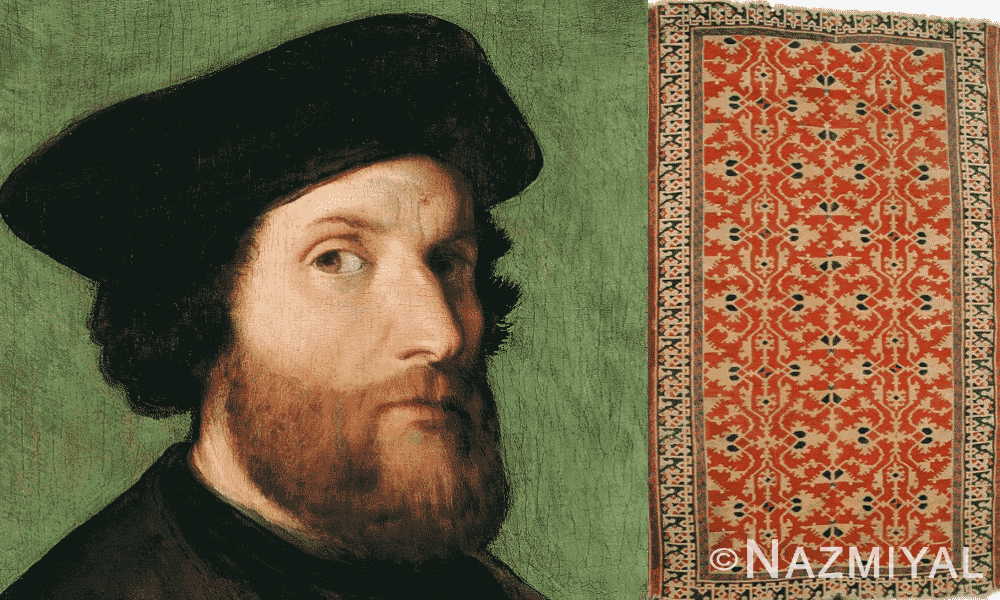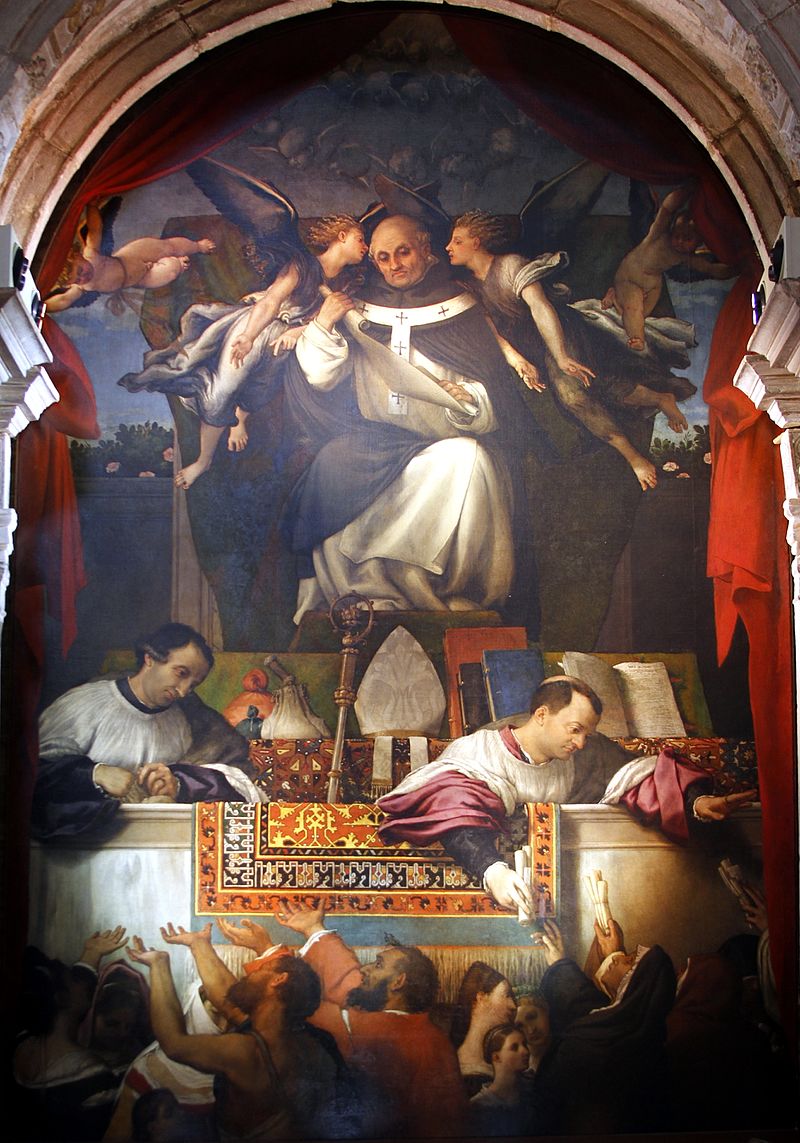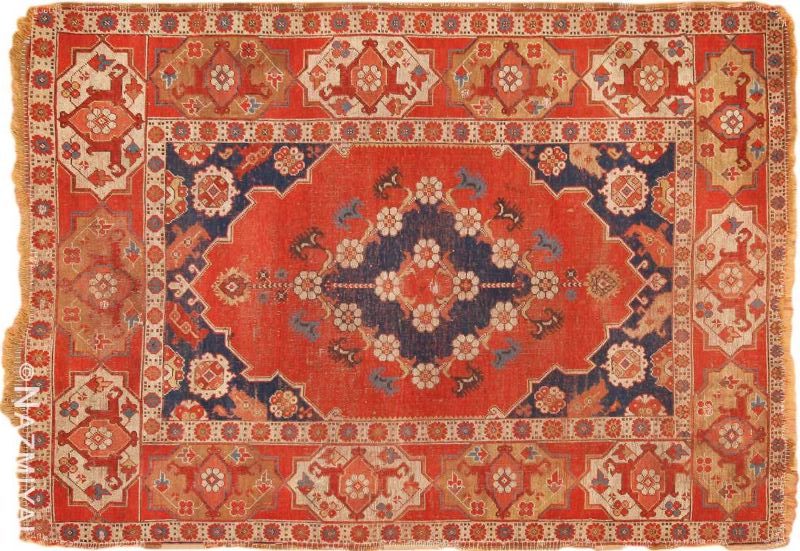Artist Lorenzo Lotto and the History of the Lotto Carpets
Who was Lorenzo Lotto?
Lorenzo Lotto (c. 1480 – 1556/57) was an Italian Renaissance painter, known for his distinctive style and contributions to the art of the 16th century. He was born in Venice, Italy, and is considered one of the prominent artists of the Venetian school during the High Renaissance.
Lotto’s works are characterized by their rich colors, intricate details, and a strong emphasis on psychological depth and individualism in his portraits. He often painted religious subjects, including altarpieces, but he also produced a significant number of portraits, which are highly regarded for their realism and the deep insight into the personalities of his subjects.
Some of his notable works include “Madonna and Child with Saints” (also known as the “Alvise Gozzi Altarpiece”), “Portrait of a Man with a Felt Hat,” “Annunciation,” and “Portrait of a Young Man with a Lamp.” His style evolved over the course of his career, and he moved away from the idealized representations of the High Renaissance towards a more naturalistic and emotionally charged approach.

Artist Lorenzo Lotto and The Lotto Carpet
Lorenzo Lotto’s contributions to the art world have earned him a lasting reputation, and his works continue to be admired and studied by art historians and enthusiasts today.
The golden age of carpet weaving
The 16th and 17th centuries are called the “Golden Age of Carpet Weaving”. Estimations based on trade records, dowries and estates suggest that hundreds of thousands of early carpets were produced and traded during that time. However, it is believed that only about 2-3,000 carpets and carpet fragments are still in existence today.
Many of these masterpieces would be lost in time forever if it were not for the work of Renaissance artists who preserved them by including them in their paintings. We owe much of what we know about a special group of antique Anatolian carpets to the Italian artist Lorenzo Lotto (1480-1556/7). This group of carpets became known as the “Lotto carpets” and they would have all but disappeared from history if not for Lotto’s paintings.

Lorenzo Lotto’s self portrait.
16th Century Anatolian Carpets
During the 16th century, the art of carpet weaving reached a peak in both the number of carpets produced and in the quality of the designs. Carpets were commissioned by royalty, wealthy noblemen and they were given as political gifts. Carpets from the Ottoman Empire were considered a sign of wealth and status in Italy and throughout the rest of Europe.
Artist Lorenzo Lotto was a Venetian trained artist who is known for his use of saturated colors and realism. The carpets painted by Lotto are characterized by a repeated field pattern with lacy, complex geometric patterns. They are typically yellow or cream colored designs on a deep red background. The actual carpets are believed to have been produced in an area along the Aegean coast of Anatolia.
Export Carpets vs. Domestic Carpets
The Lotto carpets are not typical of the carpets created for use in the Ottoman Courts. Those that were intended for use in the Ottoman Empires were usually of the medallion type layout with sweeping floral designs. Those that were made for export were generally small rugs. Carpets made for domestic use in Turkey were intended to be used on the floor. However, in Europe, many of them were made to be used on tables, which is what is depicted in Lotto’s paintings.
It is likely that Lorenzo Lotto was exposed to these geometric export carpets, as Italy was a major destination for export. The borders of Lotto carpets appear to have Kufic writing, but this was not actually writing that could be understood. It was stylized to look like calligraphy, but it was only a decorative design.

A “Lotto” carpet at the Met Museum, featuring a decoration that looks similar to Kufic script.
The Lotto Carpets and Lotto Paintings
The first Lotto carpets began to appear in paintings beginning around 1516, but the design is thought to be much older. This group of carpets seems to disappear from paintings just as quickly as they appeared around the end of the 17th century. There are a few extant carpets in existence due to the efforts of private collectors, but for the most part, the only evidence we have of their beautiful designs is through paintings of them.
The Metropolitan Museum of Art has two Lotto carpets in its collection. One of them bears the coats of arms of the Centurione and Doha families, indicating that they were probably a commissioned piece. The Victoria and Albert Museum in London also has a particularly well-preserved Lotto carpet. The Museum of Turkish and Islamic Arts in Istanbul has a unique 17th century Lotto with rosette and cloud band motifs, which is characteristic of carpets from Oushak. Aside from these, only two or three others are known to exist in the world.
One of the best examples is the Lotto carpets depicted in a painting / altarpiece made for the Church of San Giovanni Paulo in Venice. The carpets can also be seen in Lotto’s paintings Husband and Wife (1523), Portrait of Giovanni della Volta with his Wife and Children (1547), and the Charity of St. Anthony (1542).

Lorenzo Lotto’s “Husband and Wife” painting.
Lotto was not the first artist to depict these carpets in his paintings, and documentation exists that he owned more than one of these carpets during his lifetime. However, we do not know if any of the carpets depicted in his painting were of his own, or ones that he had seen elsewhere in his travels. Guessing from the number of records of the types of carpets depicted by Renaissance painters, this pattern was once quite prevalent among trade carpets.
Scholars classify the carpets found in Renaissance paintings according to the pattern and style. Many of the artists depicted a certain pattern or style of carpet, presumably because that was the prevalent type to which they had been exposed. For instance, the paintings of Hans Holbein the Younger are divided into four classifications: Types I-IV. Sometimes, Lotto carpets will be classified as Type II Holbeins, but they are distinctly different from Holbeins. The Lotto carpets have stylized plant figures rather than being comprised of simple geometric shapes. Although the layout may be similar, Lotto carpets are distinctly different from Holbeins.

“The Alms of St. Anthony”, a Lorenzo Lotto painting depicting a carpet similar to a Lotto carpet at the Met Museum.
Lasting Legacy of the Iconic Antique Lotto carpets
Because carpets are made from organic material that eventually deteriorates, and the fact that these carpets were made to be used, we know more about them through paintings than from carpets still in existence. The Lotto carpets are an important group from a historical perspective because the rug pattern seems to have sprung into existence suddenly and then disappeared as quickly, but so far, we have no explanation as to why this is so.
What we do know is that these carpets have some of the most magnificent color combinations of beautiful patterns in the history of rug making. Finding an authentic Lotto carpet is next to impossible, but through the years, they were reproduced during different time periods. Some exquisite reproductions were created as late as the 19th century. In many cases, it is difficult to tell the reproduction from the originals because the dye and weaving techniques had not changed significantly. Even the reproductions from the late 19th century are considered valuable antiques.

A late 16th century “Lotto” carpet, currently at the Met Museum.
At Nazmiyal, we occasionally have the opportunity to offer rugs from the 17th century, and we have an extensive collection of antiques. We encourage you to explore our collection of antique rugs at your leisure. We are sure that you will gain an appreciation for the magnificent pieces and workmanship that went into them.
Here are some beautiful, older antique carpets that remind us of the Lorenzo Lotto carpets:
This rug blog about the history of artist Lorenzo Lotto and the antique Lotto carpets was published by Nazmiyal Antique Rugs.















